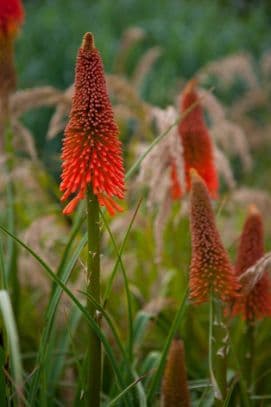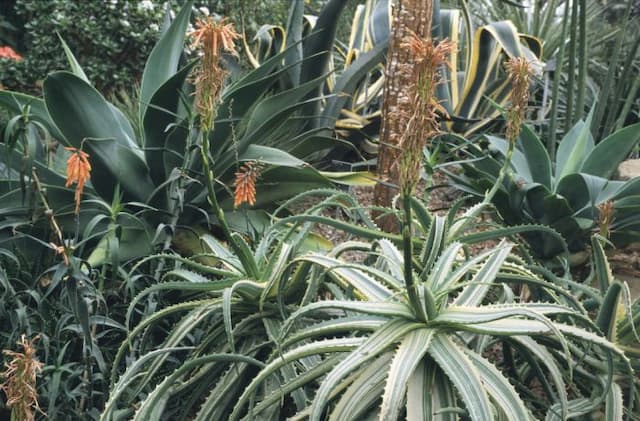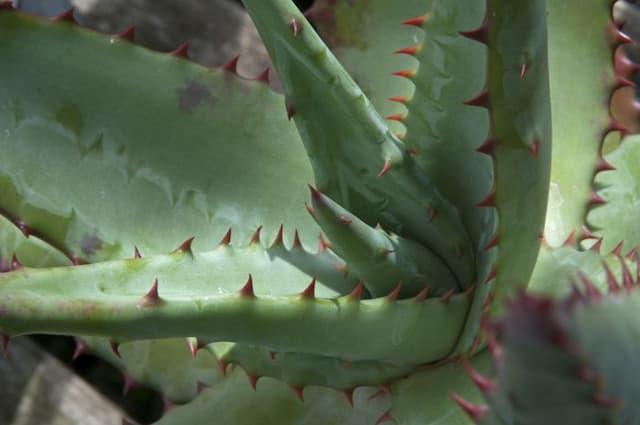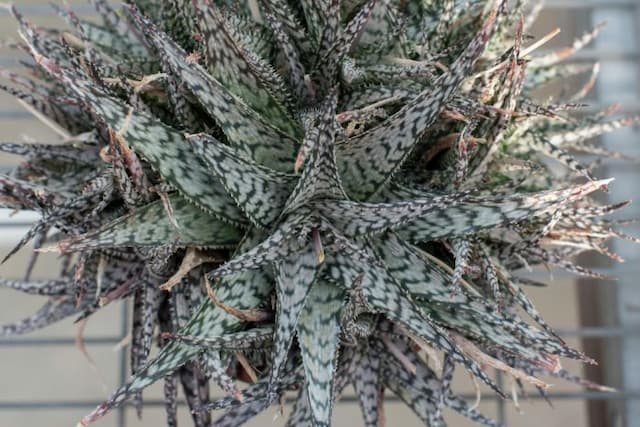Red hot poker Kniphofia 'Mount Etna'

ABOUT
The Kniphofia 'Mount Etna', commonly known as Red Hot Poker or Torch Lily, is striking for its unique flower display. The flower spikes feature a gradation of color, usually starting with a vibrant red at the top, transitioning into orange, and finally shifting into yellow at the base, reminiscent of a flickering flame. This gives the plant a very fiery appearance, hence the common names that allude to heat and fire. The tubular flowers are densely packed on upright spikes and are known to attract hummingbirds and other pollinators. The bloom period generally occurs in summer, offering a lengthy season of visual interest. The foliage of Red Hot Poker consists of a dense clump of grass-like, evergreen leaves that are slender, arching, and slightly keeled, presenting a lush base for the flame-like flower spikes. The leaves are typically a bright to a deep green shade, creating a striking contrast against the warm colors of the blooms. The overall aesthetic of the plant is vibrant and can add a tropical flair to any garden setting.
About this plant
 Names
NamesFamily
Asphodelaceae
Synonyms
Red Hot Poker, Torch Lily, Tritoma
Common names
Kniphofia 'Mount Etna'
 Toxicity
ToxicityTo humans
Red hot poker plants, including the Kniphofia 'Mount Etna', are not commonly known to be toxic to humans. Therefore, ingesting parts of the plant typically does not result in poisoning or serious health issues. However, it's always advisable for individuals to refrain from ingesting plants that are not specifically grown for consumption, as they can potentially cause gastrointestinal discomfort or allergic reactions in some people.
To pets
Red hot poker plants, such as the Kniphofia 'Mount Etna', are not regarded as highly toxic to pets. Ingesting the plant might cause mild gastrointestinal upset in some animals, like vomiting or diarrhea, but it is not expected to cause serious poisoning or life-threatening symptoms. Nevertheless, it's best to prevent pets from eating ornamental plants to avoid any potential health issues.
 Characteristics
CharacteristicsLife cycle
Perennials
Foliage type
Evergreen
Color of leaves
Green
Flower color
Orange
Height
3-4 feet (0.91-1.22 meters)
Spread
1-2 feet (0.30-0.61 meters)
Plant type
Herb
Hardiness zones
6
Native area
South Africa
Benefits
 General Benefits
General Benefits- Aesthetic Appeal: Kniphofia 'Mount Etna', commonly known as Red Hot Poker, offers striking vertical accents with its bold, torch-like flower clusters that can add visual interest to a garden landscape.
- Attracts Pollinators: The vibrant flowers are known to attract hummingbirds, bees, and butterflies, promoting pollination in the garden.
- Drought Tolerance: Once established, Red Hot Poker is drought-resistant, making it suitable for xeriscaping and water-efficient gardening practices.
- Low Maintenance: This plant requires minimal care and can thrive with only occasional deadheading and division every few years, reducing maintenance time and effort.
- Deer Resistance: Red Hot Poker is not a preferred food source for deer, which helps prevent damage to the plant in areas prone to deer browsing.
- Versatility: It can be planted in a variety of landscape designs, including borders, container gardens, and mass plantings, providing flexibility in garden planning.
- Seasonal Interest: With a bloom time from late spring to summer, it adds color and interest to gardens during these seasons.
- Soil Adaptability: It can grow in a range of soil types, although it prefers well-draining soil, making it a versatile choice for different garden settings.
- Longevity: Red Hot Poker is a perennial plant, meaning it will return year after year, offering long-term presence in a garden.
 Medical Properties
Medical PropertiesThis plant is not used for medical purposes.
 Air-purifying Qualities
Air-purifying QualitiesThis plant is not specifically known for air purifying qualities.
 Other Uses
Other Uses- Hummingbird attractant: Kniphofia 'Mount Etna', also known as Red Hot Poker, can be used in gardens to attract hummingbirds as they are drawn to the tubular flowers for nectar.
- Photography subject: The striking appearance of Red Hot Poker makes it a popular choice for photographers looking to capture vibrant flower images.
- Thematic garden design: The fiery look of Red Hot Poker can be used in garden designs that aim to create a 'volcanic' or 'hot' themed landscape.
- Seasonal interest: Red Hot Poker can be used to provide a burst of color in autumn gardens when other flowers may be fading.
- Erosion control: Due to its clumping growth habit, Red Hot Poker can be planted on slopes to help reduce soil erosion.
- Natural borders: Gardeners may plant Red Hot Poker in rows to create a natural and visually appealing border around property lines or garden beds.
- Dried floral arrangements: The tall, sturdy flower spikes of Red Hot Poker can be dried and included in decorative dried flower arrangements.
- Horticultural education: Red Hot Poker plants can serve as a learning tool in horticultural classes, providing lessons on plant care and flower structure.
- Cut flower production: Red Hot Poker is grown commercially for cut flower use, providing a unique option for florists and arrangements.
- Crafting and art: The unique shape and color of Red Hot Poker flowers can provide inspiration for crafting projects, such as making flower-pressed bookmarks or botanical prints.
Interesting Facts
 Feng Shui
Feng ShuiThe Red Hot Poker is not used in Feng Shui practice.
 Zodiac Sign Compitability
Zodiac Sign CompitabilityThe Red Hot Poker is not used in astrology practice.
 Plant Symbolism
Plant Symbolism- Standing Out: The Kniphofia 'Mount Etna', commonly known as Red Hot Poker, has a striking appearance with its bright, fiery flowers. It symbolizes the quality of standing out and being noticed.
- Passion: The vibrant red color of the Red Hot Poker is often associated with passion, intense emotion, and love.
- Attraction: Red Hot Poker plants are known to attract hummingbirds and other pollinators, representing attraction and magnetism in the human realm.
- Strength and Endurance: This hardy plant can withstand tough conditions, symbolizing resilience, strength, and the ability to endure challenges.
- Energetic Flow: The shape of the flower spikes resembles a torch or flame, symbolizing the flow of energy, life force, and creativity.
 Water
WaterRed Hot Poker plants require even moisture to establish themselves, especially during their first growing season, so it's best to keep the soil consistently moist but not waterlogged. Water Red Hot Pokers once a week, providing enough water to soak the soil to a depth of about 2 inches; this typically means using about 1/2 gallon for each plant, depending on soil type and climate. During hot, dry spells, you may need to water twice a week, while in cooler, wetter weather, reduce the frequency. Always check the soil before watering to ensure it has started to dry out slightly, as overwatering can lead to root rot. Once established, Red Hot Pokers are quite drought-tolerant and will require less frequent watering.
 Light
LightRed Hot Poker plants thrive in full sun, needing at least 6 to 8 hours of direct sunlight daily to bloom well. They perform best in a spot that receives unfiltered, strong sunlight throughout the day. A southern or western exposure is ideal for these sun-loving perennials, as it ensures they get the abundant light they need for vigorous growth and vibrant flower spikes.
 Temperature
TemperatureRed Hot Pokers prefer temperate climates and can survive temperatures as low as 10 degrees Fahrenheit for short periods, making them suitable for USDA zones 5 through 9. Ideally, they grow best in areas where the temperature averages between 60 and 75 degrees Fahrenheit. They can tolerate heat well but should be protected from extreme cold, particularly frost and prolonged freezing temperatures.
 Pruning
PruningRed Hot Poker plants should be pruned to remove faded flower spikes and to tidy up the plant, which encourages more blooms and maintains a neat appearance. Prune spent flower stalks down to the base as they finish blooming. Additionally, in early spring, trim away any old, dead foliage to make room for fresh growth. Pruning is typically done after flowering, once or twice a year, depending on the variety and climate.
 Cleaning
CleaningAs needed
 Soil
SoilRed Hot Poker (Kniphofia 'Mount Etna') thrives in well-draining soil with a pH range of 6.0 to 7.0. The best soil mix should contain loam, sand, and compost to ensure adequate drainage and fertility. To increase drainage, consider adding perlite or coarse grit to the mix.
 Repotting
RepottingRed Hot Poker plants like Kniphofia 'Mount Etna' are typically not repotted often since they are perennial and prefer to be left undisturbed. Repotting may be done every 3-5 years or when the plant has outgrown its current container.
 Humidity & Misting
Humidity & MistingRed Hot Poker plants, including Kniphofia 'Mount Etna', tolerate a wide range of humidity levels and do not require high humidity to thrive. Average room humidity is generally sufficient for these plants.
 Suitable locations
Suitable locationsIndoor
Place in bright, indirect light.
Outdoor
Plant in full sun and well-draining soil.
Hardiness zone
6-9 USDA
 Life cycle
Life cycleThe life cycle of Kniphofia 'Mount Etna', commonly known as Red Hot Poker or Torch Lily, starts with seed germination in spring under warm temperatures and moist soil conditions. Seedlings emerge and establish a rosette of narrow, grass-like leaves, gradually developing a deep root system. Throughout the next growing season, the rosette enlarges and the plant matures, producing tall, sturdy flower spikes arising from the center of the rosette in late spring to summer. The flower spikes bear tubular flowers that transition from red to orange and cream as they bloom from the bottom up. After flowering, seeds form and are dispersed, completing the reproductive cycle, while the plant itself may return to vegetative growth until dormancy in winter. Perennials like the Red Hot Poker may repeat this cycle for several years, with older plants potentially being divided and propagated for continued growth and bloom.
 Propogation
PropogationPropogation time
Spring-early summer
Kniphofia 'Mount Etna', commonly known as Red Hot Poker, is typically propagated through division, which is best done in the spring or early fall. To propagate by division, carefully lift the mature clump with a spade, making sure to keep a good amount of soil around the roots. Using a sharp knife or spade, divide the clump into smaller sections, each with at least one growing point or fans of leaves. Replant each division at the same depth it was growing before, spacing them about 18 inches (approximately 45.72 centimeters) apart to give them enough room to mature. Water the divisions well after planting to help establish them. This method is favored due to its simplicity and effectiveness in producing new, healthy plants that will flower in the following growing seasons.









